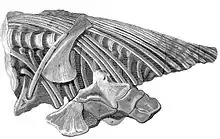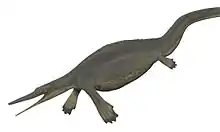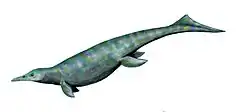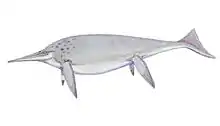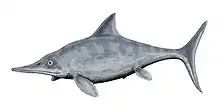Temnodontosaurus
Temnodontosaurus (Greek for “cutting-tooth lizard” - temno, meaning “to cut”, odont meaning “tooth” and sauros meaning “lizard”) is an extinct genus of ichthyosaurs from the Early Jurassic, ranging between 200 and 175 million years ago (Hettangian - Toarcian), and known from Europe (England, France, Germany and Belgium) and Chile.[1] They lived in the deeper areas of the open ocean.[2] University of Bristol paleontologist Jeremy Martin described the genus Temnodontosaurus as “one of the most ecologically disparate genera of ichthyosaurs”.[3]
| Temnodontosaurus | |
|---|---|
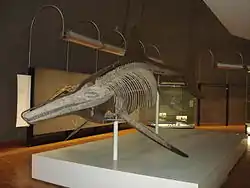 | |
| T. trigonodon skeleton in metal frame, Staatliches Museum für Naturkunde Stuttgart | |
| Scientific classification | |
| Kingdom: | Animalia |
| Phylum: | Chordata |
| Class: | Reptilia |
| Order: | †Ichthyosauria |
| Family: | †Temnodontosauridae |
| Genus: | †Temnodontosaurus Lydekker, 1889 |
| Species | |
| |
Temnodontosaurus was one of the largest ichthyosaurs. Estimates of the maximum length of Temnodontosaurus have ranged from 9 m (29.5 ft)[4] to 12 m (39 ft).[5] The largest length estimates rival those of another giant ichthyosaur, Shonisaurus popularis, which was previously considered the largest ichthyosaur.[6]
Temnodontosaurus is known for its incredibly large eyes which, at approximately 20 cm (8 in) in diameter, are believed to be the largest of any known animal.[7] It possessed a tail bend which was characteristic of Jurassic ichthyosaurs [8] and had many conical teeth filling its jaw that were set in a continuous groove.[8]
The number of valid Temnodontosaurus species has varied over the years. Christopher McGowan in 1992 believed there to be around thirteen species in the genus Temnodontosaurus.[8] Michael Maisch in 2000 listed T. platyodon, T. trigonodon, T. acutirostris, T. nuertingensis and T. eurycephalus as the valid species of Temnodontosaurus.[5]
History of discovery
The first ichthyosaur skull ever discovered was that of Temnodontosaurus platyodon. The specimen (BMNH 2149) was found in the Lias of Lyme Regis by Joseph Anning in 1811.[9] The rest of the skeleton was recovered in 1812 by his sister, Mary Anning, but has been lost since.[9] The ichthyosaur was subsequently described by the anatomist Sir Everard Home, in what was the first scientific description of an ichthyosaur. T. platyodon is the type species of Temnodontosaurus and the most common species.[8] The type skull is currently located at the Natural History Museum in London.[9] The specimen was originally named Ichthyosaurus platyodon but then renamed Temnodontosaurus.[10] The genus Temnodontosaurus was named by Richard Lydekker in 1889.[9]
The species Temnodontosaurus platyodon was named by William Conybeare in 1822 from the specimen BMNH 2003 from the Lyme Regis.[9] This specimen is located at the British Museum of Natural History.[9] T. platyodon is from the Upper Hettangian-Lower Sinemurian.[5] It is the type species for Temnodontosaurus. T. platyodon specimens have been found in England, Germany and Belgium. This includes the Lyme Regis in Dorset England, Herlikofen in Germany and Arlon in Belgium.[5] Only one complete skeleton of T. platyodon is known of (BMNH 2003) and there is also a well preserved skull (BMNH R1158).[4]

In 1995, Christopher McGowan explained that the previously named T. risor specimens are really juvenile versions of T. platyodon. The specimen he used to back up his argument was one collected by David Sole in 1987 from Black Ven (East of Lyme Regis). The previously known T. risor specimens (three skulls) were seen previously as different to the T. platyodon species because they had larger orbits, smaller maxillae and curved snouts. However, McGowan described them as juveniles because of the small size of the forefin relative to the skull. The T. risor skulls are thought to be juveniles because the skull is relatively long compared to the postcranial skeleton.[4]
The species T. acutirostris was initially named by Richard Owen in 1840.[11] This holotype (BMNH 14553) was from the Alum Shale Formation of Lower Toarcian in Whitby, Yorkshire, England.[11] Michael Maisch, in 2000, described it as belonging in the genus Temnodontosaurus.[5] However, in 2010 Maisch published a paper stating that the specimen didn't belong in Temnodontosaurus, as he had thought previously, and should probably be assigned to Ichthyosaurus instead.[11]
T. trigonodon was named by von Theodori in 1843.[6] The type specimen for T. trigonodon is an almost complete skeleton from the upper Liassic of Banz, Germany[6] of the Lower Toarcian.[5] The specimen is roughly 9.8 m long with a 1.8 m long skull.[6] Other specimens have been found in Germany and also France from the Lower Toarcian of Saint Colombe, Yonne, France.[5] A T. trigonodon specimen from the Upper Toarcian, Aalen, Baden-Württemberg, Germany[5] is at The Staatliches Museum für Naturkunde, Stuttgart in Germany (15950).[3]
The species T. eurycephalus has only one specimen, a holotype. The specimen (R 1157) is a skull and was named in 1974 by McGowan.[5][12] It is from the Lower Sinemurian, Bucklandi Zone and was found in Lyme Regis, Dorset, England in a limestone bed called Broad Ledge.[12] The T. eurycephalus specimen (R 1157) is currently located at the Natural History Museum in London.[3]

The validity of the species T. burgundiae has been disputed. In 1995, McGowan proposed Leptopterygius burgundiae should be placed in Temnodontosaurus.[6] The paleontologist Michael Maisch does not see T. burgundiae as belonging to Temnodontosaurus. In 1998, Maisch identified this name as a junior synonym of T. trigonodon.[13] Other specialists recognize T. burgundiae as a species including Martin Sander who described in 2000 specimens from the Toarcian of the Holzmaden area of Germany and from France as being Temnodontosaurus burgundiae.[7]
The species T. azerguensis was described in 2012 by Jeremy Martin of the University of Bristol. The species was described from a holotype that is almost a complete skeleton from the Bifrons ammonite zone, Middle Toarcian. It was found by 1984 by M. Dejob and Ms. Laurent from the Lafarge Quarry in Belmont d’Azergues, Rhone, France. The specific name derives from the name of the river and valley near the Belmont quarry where it was found, ‘Azergues’. It is currently located at the Musee des Amis de la Mine in Saint-Pierre La Palud, Rhone department, France.[3]
The holotype of T. crassimanus is on display at the Yorkshire Museum, however it has remained largely understudied and the validity of the species has long been questioned. Swaby and Lomax (2020) highlighted several morphological features of the postcranial skeleton and determines that T. crassimanus is a valid species of the genus Temnodontosaurus and includes several distinct characters that can be used to distinguish it from T. trigonodon, to which it was once assigned.[14]
T. azerguensis had a similar size and postcranial anatomy to other Temnodontosaurus species, however its cranial morphology differed. The rostrum was more elongate and thin and had a reduced quadrate. Since T. azerguensis either had very small teeth or no teeth at all, it has been proposed that it was probably not effective at eating hard shelled or bony prey, and instead had a diet of smaller and softer prey compared to the other Temnodontosaurus species. T. azerguensis is younger than other ichthyosaurs, originating from the bifrons ammiote zone of the middle Toarcian.[3]
Description

Temnodontosaurus had a thunniform, or "fish-shaped" body form.[8] Its body was long, robust and slender.[8] The tail was either as long as the body or longer.[5] The vertebral count was roughly less than 90.[6] The axis and atlas of the vertebrae were fused together, serving as stabilization during swimming.[13] T. trigonodon possessed unicipital ribs near the sacral region while it had bicipital ribs more anteriorly. This helped to increase flexibility while swimming.[13] Temnodontosaurus did not have gastralia.[13]
The forefins and hindfins of Temnodontosaurus were of roughly the same length and were rather narrow and elongate.[7][8] This is unlike other post-Triassic ichthyosaurs such as the thunnosaurians, which had forefins at least twice the length of their hindfins.[3][8] The pelvic girdle was also not reduced, unlike post-Triassic ichthyosaurs.[7] Like other ichthyosaurs, the fins exhibited strong hyperphalangy.[7]Temnodontosaurus only had 3 primary digits compared to Ichthyosaurus which had 6 to 7 digits.[8] It also had one postaxial accessory digit.[5] The proximal elements of the fin formed a mosaic pattern while the more distal elements were relatively round.[5] There were two notches on the fin's anterior margin.[5][7] The paired fins were used to steer and stabilize the animal while swimming instead of paddling or propulsion devices.[7] The pelvic girdle was tripartite.[7] It had a triangular shaped dorsal fin.
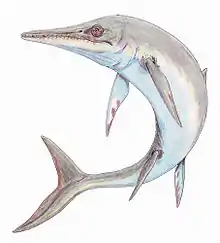
Like other ichthyosaurs, Temnodontosaurus likely had high visual capacity[15] and used vision as its primary sense while hunting.[8] Temnodontosaurus had the largest eyes of any ichthyosaur, and of any animal measured.[15] The largest eyes measured belonged to the species T. platyodon.[15] Despite the enormous size of its eyes, Temnodontosaurus had blind spots directly above its head due to the angle at which its eyes were pointed. The eyes of Temnodontosaurus had sclerotic rings, hypothesized to have provided the eyes with rigidity.[8] The sclerotic rings of T. platyodon were at least 25 cm in diameter.[15]
The head of Temnodontosaurus had a long robust snout with an antorbital constriction.[7] It also had an elongated maxilla,[5] a long cheek region[7] and a long postorbital segment.[5] The carotid foramen in the basisphenoid in the skull was paired and was separated by the parasphenoid.[5] Also, the parasphenoid had a processus cultriformis.[5] The skull of T. platyodon measured about 1 m to 1.5 m long.[4]
T. eurycephalus had a shorter rostrum and a deeper skull compared to other species, perhaps serving to help crush prey.[8] T. platyodon had a very long snout which was slightly curved on its dorsal side.[5] The snout of T. trigadon was also elongate but ventrally curved.[5] The snout of T. acutirostris was slender with a more pointed tip.[5]
Temnodontosaurus had many pointed conical teeth that were set in a continuous grooves, rather than having individual sockets. This form of tooth implantation is known as aulacodonty.[7][8] Its teeth typically had two or three carinae,[7] however the species T. nuertingensis possessed none.[5] The teeth of T. eurycephalus possessed bulbous roots.[8]
Temnodontosaurus had a weak tail bend at an angle of less than 35°.[5] The caudal fin has variously been described as either lunate[5] or semi-lunate.[7] The caudal fin was made up of two lobes; the lower lobe was skeletally supported whereas the upper lobe was unsupported.[8] The tail was used as the main propulsive force for movement; the fins were not involved with propulsion of the body.[5]
Palaeobiology
Feeding mechanisms and diet
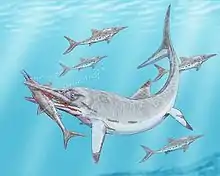
Temnodontosaurus was an apex predator in the Early Jurassic seas.[3] Its diet likely consisted mainly of vertebrates such as fish, plesiosaurs and other ichthyosaurs, and may also have preyed on cephalopods.[8] It is the only Jurassic ichthyosaur genus for which a diet consisting mainly of vertebrates has been proposed.[3] One T. trigonodon specimen (located at the Staatliches Museum für Naturkunde in Stuttgart) shows remains of Stenopterygius, another ichthyosaur, in its abdominal cavity.[16] Due to its more robust teeth and deeper jaw, T. eurycephalus probably ate large prey such as other ichthyosaurs, while species such as T. platyodon with pointed but more modest sized teeth perhaps preferred soft-bodied prey and smaller vertebrates such as fish.[6] Temnodontosaurus likely utilised ram feeding methods of predation.[17] The movements of its jaw were likely rapid and so it probably used snapping rather than chewing mechanisms to eat its prey.[8]
Swimming and movement style
Like other ichthyosaurs, Temnodontosaurus was a fast cruiser or swimmer.[8] Jurassic ichthyosaurs such as Temnodontosaurus swam via the lateral oscillation of their caudal fluke on a flexible tail stock.[13] T. trigonodon had a highly flexible, long, thin body with a high vertebral count and modest regional differentiation.[13] It used its large limbs as rudders.[13] The style of swimming was thunniform, unlike more basal ichthyosaurs whose swimming was anguilliform.[7] This trait can be inferred in Temnodontosaurus and other Jurassic and post-Jurassic ichthyosaurs due to their semi-lunate tail fins and shortened bodies relative to the tail.[7]
Classification
Temnodontosaurus is the only genus in the family Temnodontosauridae.[18][12] The family Temnodontosauridae was described by C. McGowan and is from the Lower Liassic.[5] Temnodontosauridae is part of the monophyletic group Neoichthyosauria, a clade named by Martin Sander in 2000 that includes the families Temnodontosauridae, Leptonectidae and Suevoleviathanidae.[5] Temnodontosaurus is one of the most basal post-Triassic ichthyosaurs.[11]
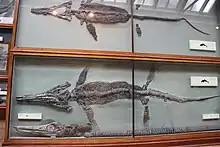
Cladogram below based on Maisch and Matzke (2000)[19] and Maisch and Matzke (2003)[20] with clade names following Maisch (2010):[11]
| Merriamosauria |
| |||||||||||||||||||||||||||||||||||||||||||||||||||||||||||||||||||||||||||||||||
Palaeoecology
The habitat of Temnodontosaurus was in the open ocean, away from the shore line.[2] It lived in the pelagic zone of the water column and didn't associate with the sea floor.[7]
Fossils of Temnodontosaurus have been found in England, Germany and France from rocks associated with marine environments. Specimens have been found especially in the Lias of the Lyme Regis in Dorset, England. The Lias is made up of alternating units of limestone and mudstone and contains many ammonites.[21] The newly described species T. azerguensis was found in a belemite rich marlstone bed in the Bifrons ammonites zone, Middle Toarcian, in Belmont d’Azergues, Rhone, France.[3]
Temnodontosaurus fossils have been found in the Posidonia Shale near Holzmaden, Germany.[16] The Posidonia Shale is composed of black bituminous shales with intercalated bituminous limestone. The environment is known to have been marine because fossils of marine animals such as plesiosaurs, crocodylians and especially ammonites have been found there in abundance.[22]
References
- Otero, R.A., Sepúlveda, P., First temnodontosaurid (Ichthyosauria, Parvipelvia) from the Lower Jurassic of the Atacama Desert, northern Chile, Journal of South American Earth Sciences (2020)
- Motani R.(2000). “Rulers of the Jurassic seas”. Scientific American. 283 (6): 52-59
- J.E. Martin et al.(2010). A longirostrine Temnodontosaurus (Ichthyosauria) with comments on Early Jurassic ichthyosaur niche partitioning and disparity. Palaeontology 55 (5), 995–1005
- McGowan, C. (1995). "Temnodontosaurus risor is a Juvenile of T. platyodon (Reptilia: Ichthyosauria)". Journal of Vertebrate Paleontology. 14 (4): 472–479
- Maisch MW, Matzke AT. (2000). The Ichthyosauria. Stuttgarter Beiträge zur Naturkunde Serie B (Geologie und Paläontologie) 298: 1-159
- McGowan C. (1996). "Giant ichthyosaurs of the Early Jurassic". Canadian Journal of Earth Sciences 33(7): 1011-1021
- Sander,P.M.(2000). "Ichthyosauria: their diversity, distribution, and phylogeny", Paläontologische Zeitschrift 74: 1–35
- McGowan, C. (1992). Dinosaurs, Spitfires and Sea Dragons. Harvard University Press
- Davis, Larry E. (2009). "Mary Anning of Lyme Regis: 19th Century Pioneer in British Palaeontology". Headwaters: The Faculty Journal of the College of Saint Benedict and Saint John’s University 26: 96-126
- Pierce, P. (2006). Jurassic Mary: Mary Anning and the Primeval Monsters. Sutton Publishing
- Maisch, Michael W. (2010). "Phylogeny, systematics, and origin of the Ichthyosauria – the state of the art" (PDF). Palaeodiversity. 3: 151–214.
- McGowan, C. (1974). "A revision of the longipinnate ichthyosaurs of the Lower Jurassic of England, with descriptions of two new species (Reptilia, Ichthyosauria)". Life Sciences Contributions, Royal Ontario Museum 97: 1–37
- Emily A. Buchholtz (2000). Swimming styles in Jurassic Ichthyosaurs. Journal of Vertebrate Paleontology, 21, 63-71
- Swaby. E.J and Lomax. D.R. (2020). A revision of Temnodontosaurus crassimanus (Reptilia: Ichthyosauria) from the Lower Jurassic (Toarcian) of Whitby, Yorkshire, UK. Historical Biology, https://doi.org/10.1080/08912963.2020.1826469.
- Motani R.(2005). Evolution of fish-shaped reptiles (Reptilia : Ichthyopterygia) in their physical environments and constraints. Annual Review of Earth and Planetary Sciences. 33: 395-420
- Thies, D. & Hauff, R.B. (2013). A Speiballen from the Lower Jurassic Posidonia Shale of South Germany”. – N. Jb. Geol. Paläont. Abh., 267: 117–124; Stuttgart
- Scheyer, Torsten M. et al. (2014). Early Triassic Marine Biotic Recovery: The Predators’ Perspective. PLoS ONE 9.3 (2014): e88987
- HIERARCHICAL TAXONOMY OF THE CLASS EODIAPSIDA. Retrieved January 16, 2009.
- Maisch MW, Matzke AT (2000). "The Ichthyosauria" (PDF). Stuttgarter Beiträge zur Naturkunde: Serie B. 298: 1–159.
- Maisch MW, Matzke AT (2003). "Observations on Triassic ichthyosaurs. Part XII. A new Lower Triassic ichthyosaur genus from Spitzbergen". Neues Jahrbuch für Geologie und Paläontologie, Abhandlungen. 229: 317–338. doi:10.1127/njgpa/229/2003/317.
- “The lithostratigraphy of the Blue Lias Formation (Late Rhaetian–Early Sinemurian) in the southern part of the English Midlands”. Proceedings of the Geologists' Association. 112(2): 97-110
- Bottjer, Etter, Hagadorn, Tang, editors (2001). “Exceptional Fossil Preservation”. Columbia University Press

